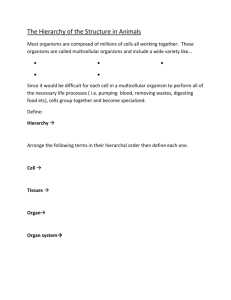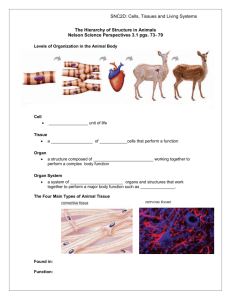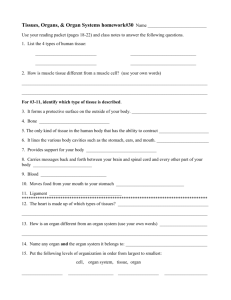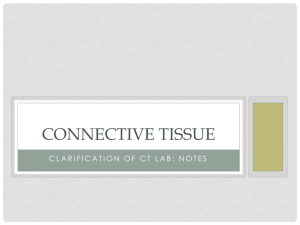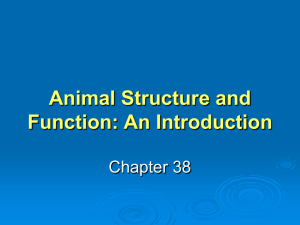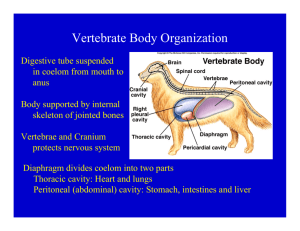Chapter 20
advertisement
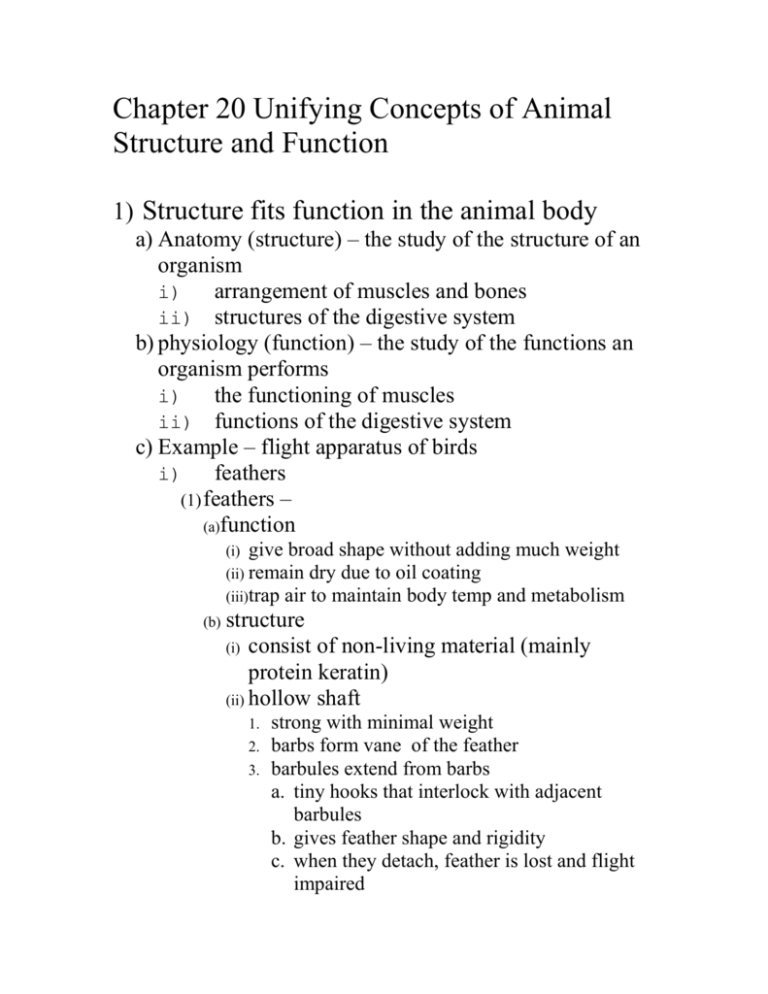
Chapter 20 Unifying Concepts of Animal Structure and Function 1) Structure fits function in the animal body a) Anatomy (structure) – the study of the structure of an organism i) arrangement of muscles and bones ii) structures of the digestive system b) physiology (function) – the study of the functions an organism performs i) the functioning of muscles ii) functions of the digestive system c) Example – flight apparatus of birds i) feathers (1) feathers – (a)function give broad shape without adding much weight (ii) remain dry due to oil coating (iii)trap air to maintain body temp and metabolism (i) (b) structure (i) consist of non-living material (mainly protein keratin) (ii) hollow shaft 1. 2. 3. strong with minimal weight barbs form vane of the feather barbules extend from barbs a. tiny hooks that interlock with adjacent barbules b. gives feather shape and rigidity c. when they detach, feather is lost and flight impaired d. birds preen – draws feathers through beaks rehooking barbs (rezips) d) bottom line – structure fits function 2) Animal structure has a hierarchy a) cellular level: muscle cell b) tissue level: many muscle cells working together c) organ level: group of tissues that perform a specific function(s) - heart d) organ system level: circulatory system e) organism level: group of organ systems working together to make a complete organism 3) Tissues are groups of cells with a common structure and function a) tissue – (latin for “weave”)cooperative unit of many similar cells performing a special function i) most cells of multicellular organisms are organized into tissues ii) the cells themselves are highly specialized to perform their function iii) Cells are held together by (1) nonliving fibers (2) sticky coating around cells (3) cell junctions (tight, anchoring, communication) iv) 4 major categories (1) epithelial – covers and lines the body and its parts (a)simple vs. stratified (b) squamous vs. cuboidal vs. columnar (c)structure fits function (obviously) (2) connective (a)cells are sparse and scattered through an ECM like raisons in bread cells produce the ECM, which is a web of fibers in a jelly (like if raisons were to make the bread) (c)Six types (First three have loose matrices (soft, mushy bread – fresh out of the oven; the last three have hard matrices – two week old bread) (i) Loose connective tissue 1. loose weave fibers (many collagen) 2. like packaging material (Styrofoam peanuts) – holds other tissues and organs in place (ii) Adipose tissue 1. fat storage 2. pads and insulates body, stores energy (iii)Blood 1. fluid rather than solid matrix called PLASMA 2. plasma a. water b. salts c. dissolved proteins 3. RBCs and WBCs are suspended in plasma 4. transports substances in body and immunity (iv) Fibrous connective tissue 1. densely packed parallel collagen fibers 2. forms a. tendons – attach muscle to bone b. ligaments – attach bones together (v) Cartilage 1. abundance of collagen in a rubbery substance 2. flexible skeletal material 3. ends of bones, nose, ears, cushioning discs b/w vertebrae (vi) Bone 1. rigid connective tissue 2. collagen fibers embedded in calcium salts a. calcium alone would be hard, but brittle b. like reinforced concrete (b) c. bone-making cells are fed through central canals with blood vessels (3) muscle (a)made up of muscle fibers (b) most abundant tissue type in animals (c)3 types in vertebrates (i) skeletal 1. attached to bones by tendons 2. voluntary 3. light and dark bands – striated (striped) – functional units 4. fixed number in adults, can grow in size (ii) cardiac 1. contractile tissue of heart 2. striated 3. branched cells 4. ends of cells joined by communication junctions to allow cells to signal each other 5. involuntary (iii)smooth 1. lack of striations…hence smooth 2. walls of digestive tract, urinary bladder, arteries and other internal organs 3. spindle shape 4. slow endurance cells – contract slow but can sustain for long time unlike skeletal 5. involuntary (4) nervous (a)forms a rapid communication system (b) senses stimuli, processes and directs response (c)neuron = a single nerve cell (i) specialized to conduct signals (ii) cell body, dendrites and axon (iii)axon can be a meter or more long transmission from one place to another usually involves a chain of neurons (e)neurotransmitters allow cells to talk to each other (f) many other non-neural cells make up nervous tissue 1. schwann cells – wrap neurons and insulate 2. glial cells – provide support and nutrition (d) 4) Several tissues are organized to form an organ (organ = group of tissues working together to perform a specific function(s)). a) Example: small intestines i) columnar epithelium – lines lumen, secretes mucous and digestive juices (enzymes) (1) villi – fingerlike projections – increase surface area for more efficient digestion ii) connective tissue – loose connective tissue – contains nerves and blood vessels iii) Smooth muscle layers (2) – move food through digestive tract (peristalsis) iv) Another layer of connective tissue b) Bottom line: tissues cooperate and new levels of structure and function are achieved 5) The body is a cooperative of organ systems a) organ system – group of organs that work together to perform vital life functions b) Twelve major organ systems in vertebrates i) Digestive system ii) Respiratory system iii) circulatory system iv) lymphatic system v) immune system vi) excretory system vii) endocrine system viii) reproductive system ix) x) xi) xii) nervous system muscular system skeletal system integumentary system
